This essay by John Bold on the Painted Hall at the Old Royal Naval College began as a book review but it grew. It is intended for publication in the Transactions of the Ancient Monuments Society (Vol 65, 2021)
Lucas, Anya, Johns, Richard, Stewart, Sophie and Paine, Stephen, The Painted Hall, Sir James Thornhill’s Masterpiece at Greenwich, London and New York: Merrell (2019), 160 pp., c.150 ills. £40. ISBN 978-1-8589-4679-5.
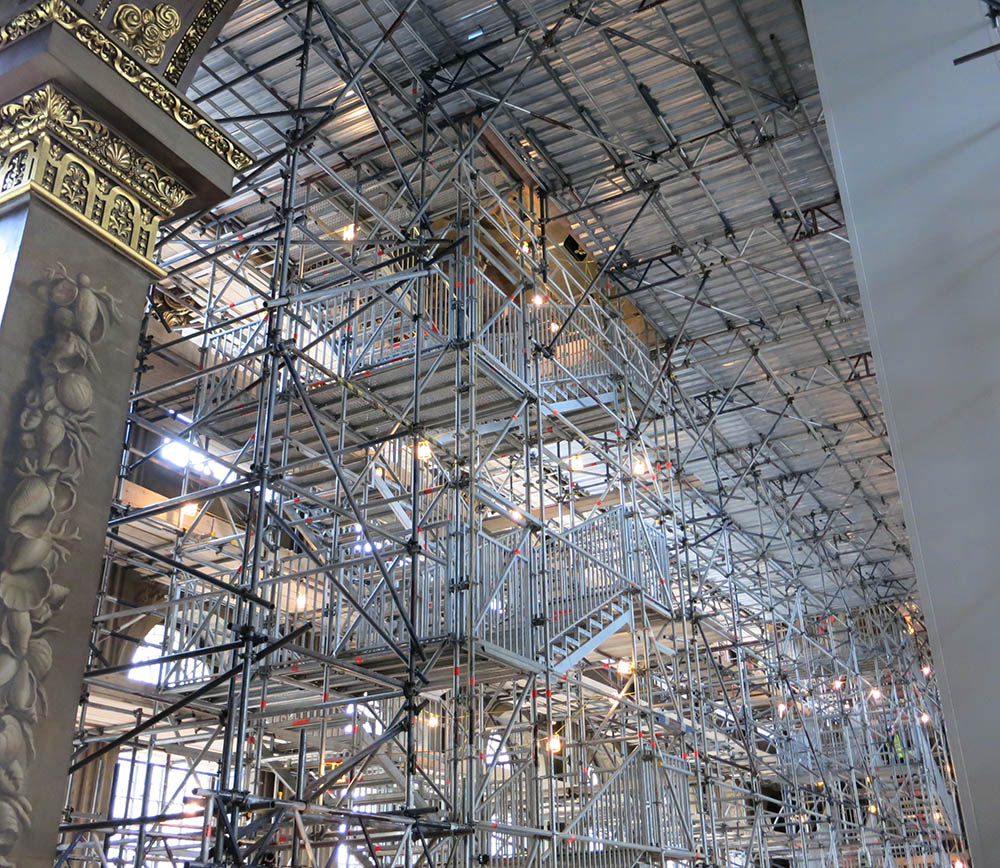
This handsome publication, produced to mark and commemorate the completion of the comprehensive restoration of the Painted Hall at the Old Royal Naval College, Greenwich (originally the Royal Hospital for Seamen), is a credit to all involved, not least the now departed Conservation Director of the Greenwich Foundation, William Palin, who has successfully overseen the project amidst challenging circumstances. Project and publication have been part-funded by the National Lottery Heritage Fund. Work began with a pilot project in 2012-13 on cleaning the west wall and Upper Hall ceiling; the remaining 40,000 square feet (3,700 sq.m) of the Upper and Lower Halls and Vestibule followed (September 2016 – March 2019). Public engagement was fundamental to the presentation of the project with almost 100,000 visitors taken within surprisingly disorientating, too-close-for-context, touching distance of the ceiling on a floor raised on a forest of scaffolding (Fig.1). The completion of this restoration along with that of the magnificent colonnaded dining hall undercroft represents the culmination of the first twenty years of stewardship of the buildings by the Greenwich Foundation, established in 1998 following the departure of the Royal Navy, ‘to preserve for the benefit of the nation the old Royal Naval College site, buildings and monuments, as being of historical, architectural and artistic importance, to allow the general public reasonable access to the site, and to educate the public thereon’. Access to the Painted Hall, which was restricted for the non-uniformed under the stewardship of the Royal Navy, became miraculously easy and free under the new management, but following the cleaning a charge of £12 per adult has been imposed – this ticket is valid for twelve months, which is perhaps acceptable for those enthusiasts who live nearby, but potentially disabling for casual or occasional visitors and perhaps not in the spirit of reasonable access and education about a great but relatively little known work of art (Fig.2).

This is after all the finest piece of baroque mural painting in this country, painted 1707-26 by the Dorset-born Sir James Thornhill during the great efflorescence of later 17th and early 18th-century mural painting, which followed the earlier examples by Rubens (Banqueting House) and Gentileschi (Queen’s House), but essentially was begun in earnest in the 1670s-1680s by Antonio Verrio and Louis Laguerre, continued by Sebastiano Ricci, Antonio Pellegrini and Jacopo Amigoni. Knowledge and understanding of these remarkable allegorical demonstrations is in inverse proportion to their scale. Popular histories of British painting tend to begin with Thornhill’s son-in-law William Hogarth and tend to lay their emphasis on the identifiable and recognisable – portraits, land- and sea-scapes, national triumphs and snatches, often moralising, of social life – rather than the teeming mass of gods and goddesses defying gravity as they alternately skim and stutter across the sky in celebration (in the case of Greenwich) of Peace, Prosperity and the Protestant Succession, the latter displacing the fanciful and symbolic with the recognisably corporeal William and Mary, Anne and George, George I and his family.
In recent years there has been an increase in scholarly attention to these English baroque works, though such attention lags way behind the significance which is accorded its Italian equivalents. There have been notable essays on Verrio and Hampton Court by Cécile Brett and Brett Dolman in the British Art Journal; Lydia Hamlett has a chapter on painted interiors in the Tate’s British Baroque – Power and Illusion, edited by Tabitha Barber (2020, accompanying the curtailed exhibition), and she has published her book on Mural Painting in Britain 1630-1730 (which priced at £120 surely will struggle to reach a wide market); at Greenwich Anya Matthews curated a notable exhibition and catalogue of drawings for the Painted Hall, ‘A Great and Noble Design’ (2016); and we continue to anticipate Richard Johns’ long-awaited monograph on Thornhill, the artist recognised as long ago as 1953 by Ellis Waterhouse as ‘the least studied in detail of the eminent names in British painting’ (Painting in Britain 1530-1790). This relative neglect of a major phase of British art and its main native-born exponent may be attributed in part to the phenomenon remarked by Colen Campbell in matters pertaining to building – ‘so many of the British Quality have so mean an Opinion of what is performed in our own Country; tho’, perhaps, in most we equal, and in some things we surpass, our Neighbours’ (Vitruvius Britannicus, I, 1715). We might also paradoxically attribute the under-estimation of mural painting to the efforts of its greatest chronicler, Edward Croft-Murray, whose ground-breaking, two-volume Decorative Painting in England 1537-1837 (1962-70), long out of print, not only rather understated Thornhill’s abilities – weak and uncertain in modelling, but pleasing in colour – also and more importantly chose ‘Decorative Painting’ for his title, rather than ‘Mural Painting’, as it is understood today to include the implied ceiling, or ‘History Painting’ as it was known at the time (William Aglionby in 1685, pre-Thornhill, quoted by Croft-Murray: ‘we never had, as yet, any of Note, that was an English Man, that pretended to History-Painting’). There is a terminological problem. ‘Decorative’ in English usage has connotations of the frivolous and light-hearted, the dilettante, the less than serious, quite often preceded by ‘merely’; for Dr Johnson (Dictionary, 1755) to decorate was to adorn, to embellish, all very far from the ‘Grand style’ praised by Sir Joshua Reynolds in his Discourses (from 1769), far also from the judgment of Hogarth on the Painted Hall (intended for inclusion in The Analysis of Beauty, 1753) which ‘remains fresh, strong and clear as if it had been finished but yesterday ……. France in all her palaces can hardly boast of a nobler, more judicious or richer performance of its kind’.
The high seriousness of Thornhill’s endeavours and his remarkable achievement on behalf of the governors of the Royal Hospital for Seamen is well and succinctly brought out in this book. This was a deeply considered, exceptionally well-judged work of art which maintains its coherence through three separate, related spaces – Vestibule, Lower and Upper Halls – most notably in the single field of the great Lower Hall ceiling where Thornhill created a fictive architectural framework to contain his complex allegory, to be read by the static viewer from prescribed points. This is not yet the vast, populated open sky of Tiepolo, revealing its meanings as the viewer walks through the space below, but it is considerably more expansively open, with more views and vanishing points than could be essayed by Rubens and Gentileschi, constrained as they were by Inigo Jones’s compartmentalised Venetian ceilings. Although the idea of painting the great dining room of the King William building was not foreseen at the start of its construction in 1698, it may nevertheless be interpreted as a further manifestation of the founder Queen Mary’s ‘fixt Intention for Magnificence’, recalled by the principal executant architect of the Hospital, Nicholas Hawksmoor, who began as assistant to the master-planner, Surveyor to the Hospital Christopher Wren before as official Clerk of Works (1698-1735) designing much of its detail and seeing three quarters of the building through to completion, in effect as unofficial Deputy Surveyor. His Remarks on the Buildings (1728) is an impassioned love letter and a setting to rights to counter those who might countenance a reduction in quality, cost and extent rather than completing this greatest of public buildings according to the original vision: ‘capacious and durable, as well as regular and beautiful’. He was writing in the spirit of his mentor, since Wren had himself expressed (in the 1670s) the sentiments which later informed the design and decoration of Greenwich Hospital from first to last: ‘Architecture has its political Use; publick Buildings being the Ornament of a Country; it establishes a Nation, draws People and Commerce; makes the People love their native Country, which Passion is the Original of all great Actions in a Common-wealth’ (Tract I).
Thornhill first appears in the minutes of the Hospital governors in July 1707 – as soon as the scaffolding is ready, he should proceed to painting, priming it himself or employing his servants, ‘and that he make such Alterations in his design by inserting what more he can relating to maritime affaires till the same shall be approved by this board’. By this time Thornhill had been commissioned to paint the saloon and staircase for the 1st Duke of Devonshire at Chatsworth and it may be surmised that this connection with the Whig grandee, a benefactor and director of the Hospital, did him no harm in securing the Greenwich job, with no evidence for any sort of competition. Anya Lucas (formerly Matthews) tells the story of the building of the Hospital, the construction and preparation (high quality plastering by Henry Doogood) of the Painted Hall and Thornhill’s engagement with admirable fluency, detailed research and authoritative judgment. This, over three short chapters, immediately takes its place as the best available summary introduction to the Hospital – its architecture and politics well interwoven – and its principal artist. There are places however where a less concise approach would enable better explanation. Hawksmoor was indeed dismissed during the surveyorship of Thomas Ripley, but ‘shabbily’ is arguable, since Ripley had latterly been paying him out of his own pocket. In discussing the unusual layout of the Hospital – two sides without a centrepiece because of the retention of the much smaller Queen’s House – reference might have been made to the identical problem faced by John Webb in his 1660s design for a palace on this site for Charles II. He too was thwarted by the Queen’s House so had recourse to designing a ‘grott and ascent’ on the hill to the south in order to close the view. In fact both Inigo Jones’ great iconic buildings, the Queen’s House and the Banqueting House, in their self contained harmony and restraint inhibited the more expansive baroque intentions of his successors who sought to incorporate them in later designs for both Greenwich and Whitehall Palace. It could perhaps also have been made clearer that although Wren in a ‘shrewd piece of masterplanning’ had caused all the foundations for the whole site to be laid out at the start, ensuring that failure to complete the full design would be a very visible embarrassment, nevertheless the detail of the design did evolve over the five decades of construction. Although they have domes in common, Ripley’s utilitarian Queen Mary building (including the Chapel) differs radically within and without from Hawksmoor’s magisterial King William building opposite (the two buildings originally conceived as identical pendants), which houses the Painted Hall. Lucas notes that the King’s House (John Webb’s pattern-setting, unfinished building from King Charles’s abortive palace project, which survived to serve as the first range of the Hospital) was given a linked base wing to the west in red brick. Visitors today may wonder where this has gone, so a note on the development of the design would surely have been helpful in explaining the architecture and demonstrating its complex evolution: in pursuit of ‘magnificence’, grand stone pavilions were added first at the river front of the red brick building in 1712-15 and then at the southern end in 1769-74, the red brick wing itself being replaced in 1812-15 by the colonnaded stone-faced range designed by John Yenn to present a grand front to the town and to departing sailors on the river, reminding them of the power of the Royal Navy and the beneficence of a state which provided such palatial surroundings for its veterans.
Further discussion might also have enabled the fuller exploration of the practicalities of the painting process, including the extent of the scaffolding. This clearly falls into the well-known historical category of ordinary, everyday things, so well known and understood at the time that they do not need to be described for the benefit of a posterity which finds itself with fragmentary information and imperfect understanding. Lucas does her best with the available evidence, but we still cannot be sure whether the whole of the hall ceiling had a fixed scaffold for the duration of the project or whether some parts were movable. We know from the well-known anecdote about Thornhill’s being prevented by the quick reactions of an assistant from falling off the scaffold when painting the dome of St Paul’s Cathedral that scaffolding did not necessarily cover the whole of the area to be painted all the time and one part at least had to be openable for access. At Greenwich there are two reasons for thinking that it might have been wholly covered – firstly that an opening had to be made in the scaffold so that the Duke of Ormond could view the painting and secondly in the same year (1713) Edward Strong the mason complained of the waste and consumption of the Hall scaffolding which had stood four years longer than first intended and he had been obliged to buy more. Both these suggest total coverage, but this then raises the question of how Thornhill did the job – how did he visualise it in order to paint it without being able to contextualise the component parts from distance? How did he physically see in order to paint? – as the restorers in the 1950s found, a fully scaffolded ceiling limits both light and ventilation. As noted, some visitors to the scaffolding during the recent restoration, certainly this reviewer, found the experience of viewing the ceiling from painting-cleaning distance remarkably disorientating: figures, well understood from floor level frequently appeared to be in an unexpected relationship at ceiling level. Although there are several preparatory sketches, previously catalogued by Matthews, they are not templates for the artist to transcribe onto the plaster. So did he draw directly, then paint, or were there drawings to follow, now lost? – there are no pounce marks to suggest the original laying out. Further investigation is needed on the practical question of how ceiling paintings at this time were carried out as well as the roles of assistants, who must for such a project have been numerous. Wider investigation of the context and the practice elsewhere by Verrio, Laguerre and others may yield more information.
Upon completion of the whole of the Painted Hall, Thornhill in 1726/7 published in English and French ‘by Order of the Directors … for the Benefit of the CHARITY-BOYS’ his detailed Explanation of the Painting in a sixpenny booklet to be sold by the porter to the many visitors to this tourist attraction. This invaluable guide to the iconography and the political and maritime messages of the painting could usefully have been included in this volume as an appendix – it would have complemented very well the helpful annotated photographs which identify the dramatis personae – instead it is available as a separate publication in facsimile. Richard Johns, in his contribution to this volume on ‘Image and Meaning’, uses extracts from Thornhll’s Explanation as a prompt for a discussion of aspects of the making and meaning of the painting. We begin with the paintings that were completed last in the long programme of works, in the entrance Vestibule beneath the dome where trompe l’oeil tablets recording the names of benefactors are supported by winged figures and Charity-Boys (not less than twenty sons of mariners to be maintained), painted to look as if they have been carved in marble. They gesture upwards towards the windows where larger-than-life figures of Charity in a niche (painted on canvas, now lost) once stood. In this section, as in the earlier chapters by Lucas, more explanation and description would have been helpful, and in the selective discussion of the painting, it is not always clear where we are on the ceiling. But Johns is aided by exceptionally detailed photographs, including a gatefold of the Lower Hall ceiling, and is eloquent in his description of the impression achieved by Thornhill of pictorial and political unity, with its ‘chorus of Virtues and other personifications that appear at each stage of the scheme’ so ‘the Painted Hall may be likened to an operatic production of the most ambitious kind’. This is a production with a very clear message as Johns shows in an analysis of the ceiling and the accompanying booklet which would resonate with political imagineers in any age: ‘But if the official Explanation gives visitors access to the vocabulary and grammar of grand-scale decorative painting, it also exercises a high degree of control over that experience, guiding us from one part of the Hall to another, giving cause to dwell on some parts of the painting while glossing over other details with a cursory ‘&c’. It encourages the viewer to read the scheme in a particular order … and therefore to understand the whole as a seamless celebration of the nation’s recent royal past, united by the common themes of national prosperity and miltary success’.
As Kerry Downes has shown, the baroque is a style in which ‘appearances take precedence over essences’ (Grove Art Online: Baroque), hence the characteristic blurring of the real and the fictive which we see in the Painted Hall: ‘Underneath [William and Mary] is a Figure of Architecture holding a DRAWING of Part of the Hospital, and pointing [with her left hand] up to the Royal Founders’ (Fig.3). Here is a double message which enables two interpretations which are not mutually exclusive: (i) the drawing shows Architecture with her right hand pointing to the King William building, indeed pointing towards the place in the building, the Painted Hall, where she herself is being depicted; (ii) through the presence of Time to the right of the drawing, ‘bringing Truth to Light’, providing as Johns points out ‘a subtle reminder to the Hall’s early visitors that another, equal part – the Queen Mary building – had still to be built’. As identical pendant designs, the same drawing serves for both.
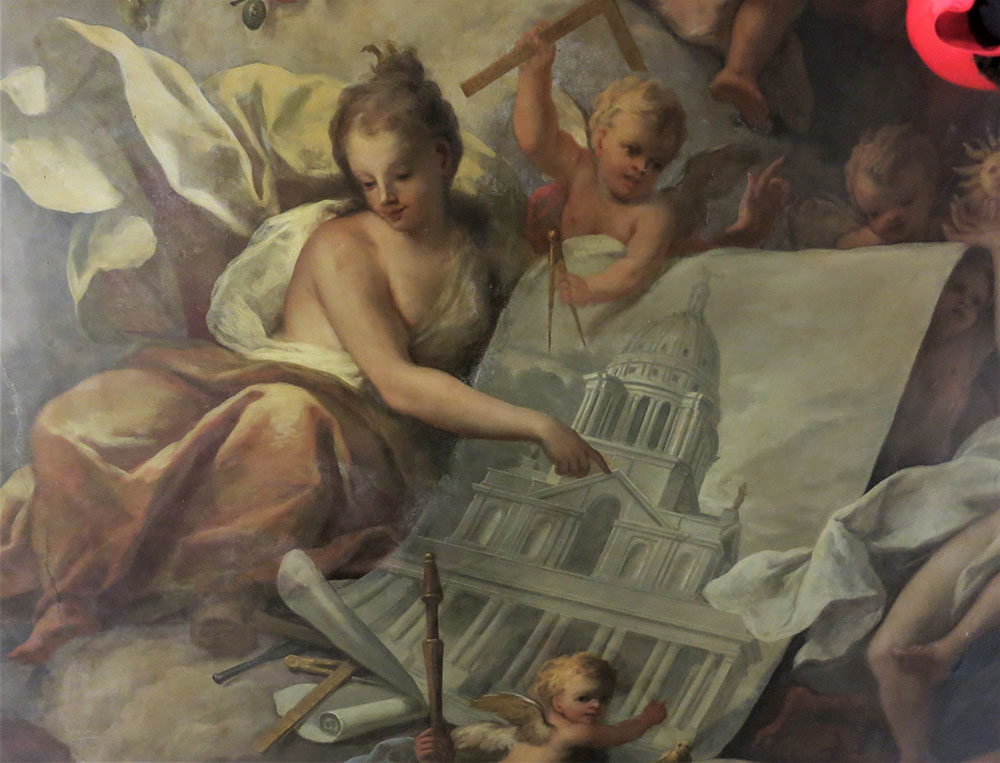
In one of the two large Protestant Succession paintings on the side walls of the Upper Hall, Thornhill again depicts part of the Hospital, the river front of the King Charles building as backdrop to the arrival of King George I in 1714. Together with the painting opposite on the other side wall of the Upper Hall depicting William III welcomed by Britannia in Torbay in 1688, this is rendered in grisaille – stone colour recalling bas-reliefs – with the participants in classicising dress and poses. As Reynolds was later to observe, the grand style is informed by the ‘general and invariable ideas of nature’ rather than attending to ‘the minute accidental discriminations of particular and individual objects’: the artist ‘must sometimes deviate from vulgar and strict historical truth in pursuing the grandeur of his design’. He would have approved of the strategy employed here by Thornhill who recorded his thoughts on a preparatory drawing: George had arrived at night, no ships were visible, certain of those present at the time of the landing were by the time of painting no longer in political favour, the king’s dress was not enough worthy of him to be transmitted to posterity – so Thornhill went for appearances as they should have been rather than essences as they were: King George arrives in a horse-drawn chariot in Roman dress accompanied by St George on horseback, trampling a dragon, with Religion, Liberty, Truth and Justice in front, Eternity above, preceded by Fame who appears to be pointing her trumpet towards the Painted Hall where we also are anticipating the arrival of the new king whose dynasty is further celebrated on the great west wall as a golden age restored. Within a fictive architectural framework, a curtain is drawn back to reveal the king and his family, many of whom here play a dual role in symbolising the Virtues, accompanied by Justice and Time, enabling Peace and Plenty to bring forth a cornucopia of riches in this best of all possible worlds.
Notwithstanding the grandeur of the conception, the west wall is an uncertain climax to the great sequence of painted spaces. Work on the Lower Hall was completed by 1714, but work on the Upper Hall did not begin until 1718. An original window in the west wall had been blocked in 1713 to allow for a painting featuring Queen Anne, but by the time terms of payment and subject matter had been agreed between the artist and the governors, the Hanoverian dynasty had succeeded the Stuarts. The two side windows were blocked and the whole wall plastered on a wooden frame for painting (movement of the frame causing cracking of the plaster was detected in the 1950s). According to Hogarth ‘the upper end of the hall where the royal family is painted, was left chiefly to the pencil of Mr.Andrea a foreigner, after the payment originally agreed upon for the work was so much reduced, as made it not worth Sir James’s while to finish the whole with his own more masterly hand’. Thornhill was assisted here not only by the portrait painter Dietrich Ernst Andreae, but also by Robert Brown, renowned for his skill in painting drapery, who is presumed to have painted the theatrical curtain. The cleaning of the paintings has also enabled the identification of another hand in the painting of the Upper Hall ceiling, that of the highly accomplished French flower painter Antoine Monnoyer who was in London between 1714 and 1729. His flowers sit in vases at each of the four corners of the deep coving of the ceiling between the personifications of the four continents, all admiring the display of British maritime power expressed within the fictive architectural framework (Fig.4). Here in an adaptation from Virgil’s Aeneid, Juno instructs Aeolus to still his winds in order to calm the sea, enabling Neptune to hand dominion over the waters to Lord High Admiral Prince George of Denmark, consort of Queen Anne, both shown here in a double portrait in a roundel supported by appropriate Virtues.
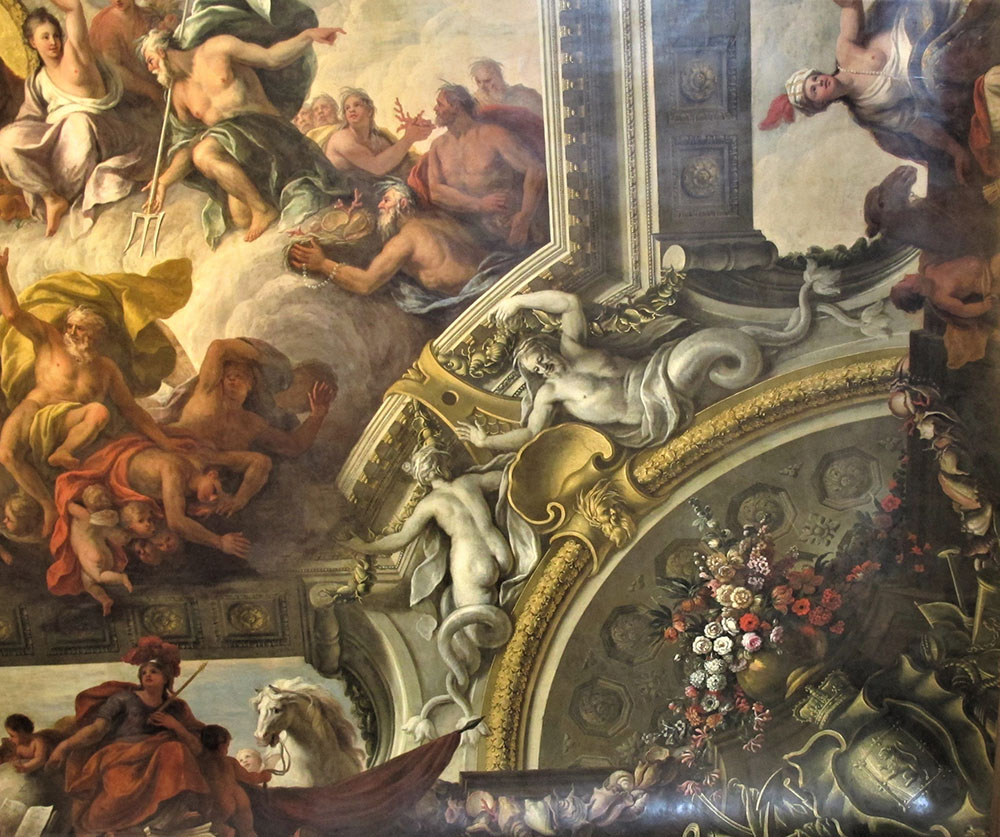
Richard Johns sums up this whole glorious fantasy very well, this ‘grand illusion’ of a sort which continues in fact, 300 years on, to colour our political discourse: ‘Thornhill was keenly aware of the political function of decorative painting and of the propaganda value of the role that he performed. His job, simply put, was to make the accidental and temporary appear inevitable and permanent; to craft a vision of modern Britain as a plentiful, pious and victorious nation, well governed by the right people’. This as Johns points out was a grand illusion that Thornhill wilfully entered into, including himself on the west wall only three steps below the king who had appointed him History-Painter in Ordinary in 1718, Serjeant Painter in March 1720 and knighted him two months later: ‘he was, for a short time at least, the most celebrated British artist who had ever lived’. Although he later fell from favour and fashion with Lord Burlington’s promotion of William Kent, a good architect, but a terrible painter, his obituarist in 1734 acknowledged him as ‘the greatest History Painter this kingdom ever produced’, a judgment endorsed by Whinney and Millar in their standard history: ‘not only the greatest history-painter the country had produced , but the first of whom no court in Europe need be ashamed’ (English Art 1625-1714, 1957).
The paintings in the Painted Hall have been subject to frequent interventions from as early as 1733. As Sophie Stewart and Stephen Paine explain in the final chapter of this book, wall paintings are at constant risk through their innate relationship with the fabric of the building: moisture, light, accessibility, vulnerability to uncontrollable environmental conditions, a situation exacerbated in the Thornhill period by the painting techniques employed – multiple layers of fragile pigments with delicate glazes and areas of gilding. Cleaning and restoration have frequently been heavy handed, involving repainting and ‘haphazardly applied coatings of natural resin varnishes’. The efficacy of treatments has tended to be short-lived and the day-to-day use of the building has also speeded deterioration and prompted further interventions – smoke from heating and candle-lighting, humidity, pipe and cigarette smoking have all had an impact. In 1957-60 a team of conservators from the Ministry of Works identified more than fifteen individual layers of varnish and found twenty-two signatures from 1733 onwards (a further ten have been found since), one of them extraordinarily applied in 1777 to the décolletage of Queen Mary. This programme of cleaning, removing all non-original varnishes as far as possible, is here described in detail and acknowledged as a great achievement, thanks not least to the team’s leader, the pioneering paintings conservator Westby Percival-Prescott. Consideration was given in the cleaning programme completed in 2019 to removing the 1950s varnish, but it was decided that this was not merited and that surface cleaning ‘would lead to an impressive improvement in the brightness and definition of the whole scheme’. And so it has: the Painted Hall is now as close to its original appearance as it is possible to achieve. Much has been learned by the restorers about the process of painting – first the fictive architecture was completed and the figures followed – architectural framing is visible behind some figures as the result of some thinning of the paint over time; there is evidence of other hands, some identified; there are very few corrections or alterations so the painting must have been very precisely planned, although the painting of St Paul’s Cathedral, the architectural wonder of the age (with which Thornhill was also involved) floating in ambiguous space on the west wall behind the royal family is not discussed here. It looks like a rather uncertain afterthought, but the cleaning process in 2012-13 confirmed that its painting was coeval with the rest of the wall although it was changed in the execution – there were said to be signs that initially the dome was painted at a higher level, but had to be dropped to accommodate the lantern below the soffit of the fictive proscenium arch (Fig.5). Such alterations are rare in the Painted Hall, but despite all the close investigation, we still do not know how Thornhill and his team transferred the design from paper to wall and ceiling. This is an exceptionally well planned, clever work of art, carried out over nineteen years and necessarily adapting to changing political circumstances. As Anya Matthews observed in her catalogue of the drawings, this is both a visual and a political illusion – ‘This illusion of coherence, assisted by the use of recurring motifs and fictive architectural frameworks, is testament to the artist’s prodigious skills as a decorative history painter…. able to ….generate an appearance of wholeness when both the artwork – and the events it depicts – were in fact characterised by a high degree of contingency’.
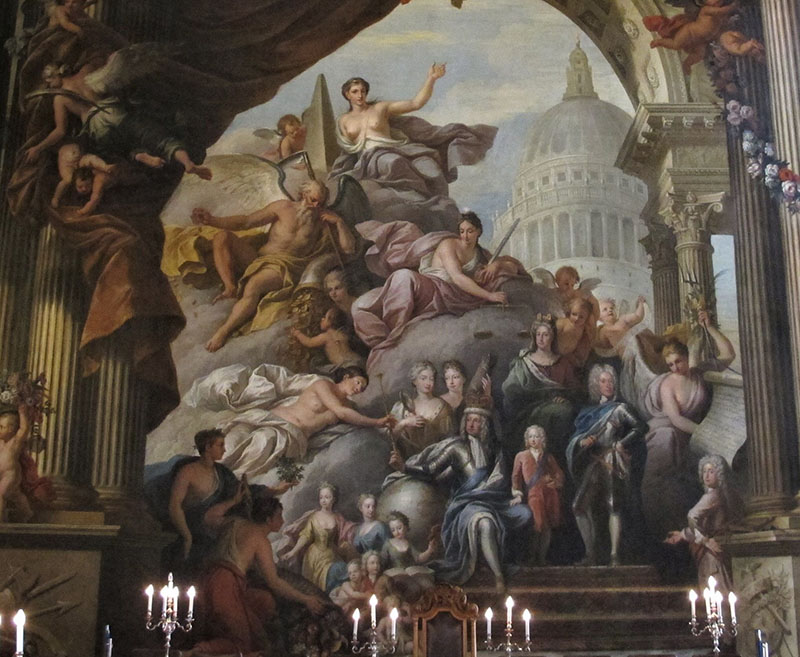
In his Director’s Foreword to British Baroque, Alex Farquharson refers to this period of painting as ‘one of the least familiar areas of British art history, which, in general overviews, is usually hurried over on the journey from Van Dyck to Hogarth’. But perhaps this is because Thornhill represents an ending to a tradition, a triumphant culmination, whereas Hogarth is a beginning. The triumph is clear and is clearly brought out in the book under review. For Kerry Downes, this was ‘one of the greatest achievements of decorative painting in the whole period … all the artifices of Catholic or absolutist quadratura were employed to deliver a nearly republican message in praise of the Glorious Revolution of 1688, and of the constitutional monarchy and the Protestant settlement that followed from it’. He later explains this idea of an ending: the baroque is ‘based on a long tradition of growing familiarity with canons and methods ….. [allowing] the visual language to be adapted as only a mother tongue can be, to metaphor, wit, punning … it is an art related more immediately to the beholder than to abstract principles. It has the richness and diversity of form and language that come at the end of a continuous period …. specifically that of the Renaissance, on whose forms and language it depends’. We do not know enough about Thornhill’s sources – clearly he was influenced by Verrio and Laguerre; also he was able to draw on John James’s translation (1707) of Rules of Perspective, by Andrea Pozzo, the Roman baroque quadratura painter of the ceiling of S.Ignazio, a publication endorsed by Wren, Hawksmoor and Vanbrugh. Thornhill made two journeys to continental Europe – to the Low Countries and to France where he would no doubt have studied the work of Le Brun. He was a collector – Matthews records his owning paintings by Annibale Carracci and Poussin – and he would have had access to a large number of Renaissance paintings through prints. He was a student of the greatest of Renaissance painters – he freely learned and borrowed from the gestures and postures of Raphael (see for example both Peace (Fig.6) and Europe (Fig.7) in the Lower Hall ceiling). He spent his later years in the absence of commissions in making at least three sets of copies of the Raphael tapestry cartoons in the Royal Collection at Hampton Court as pedagogical guides for others. He had come full circle.
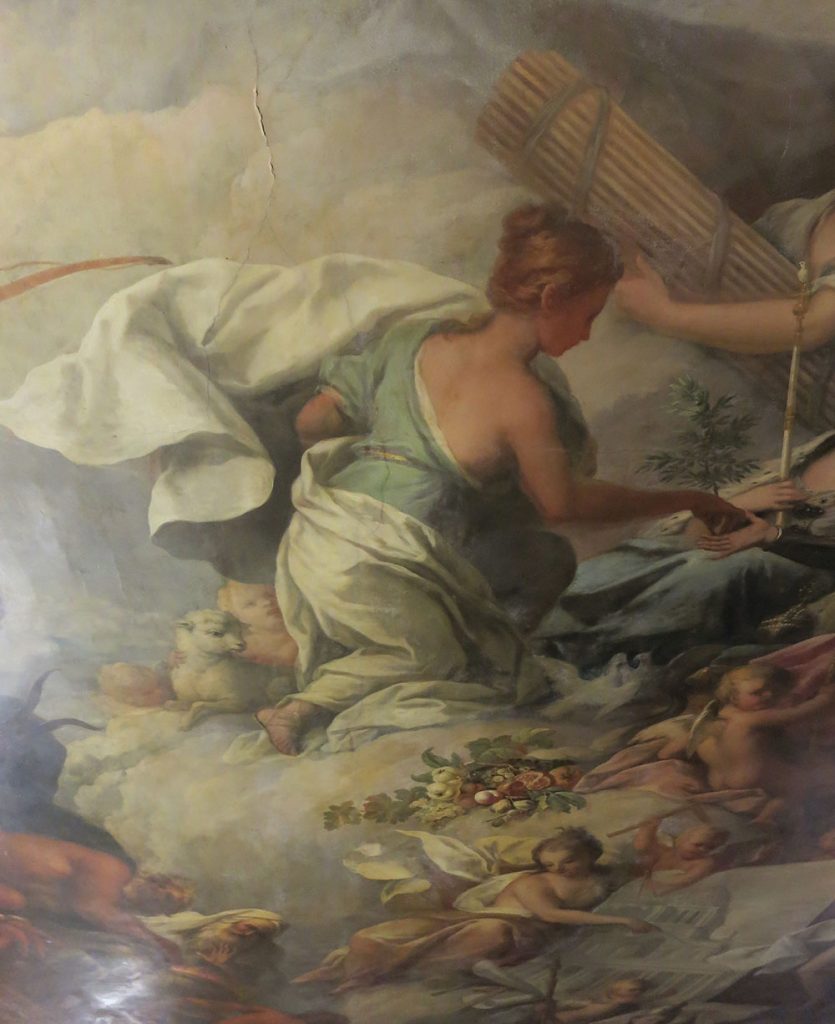
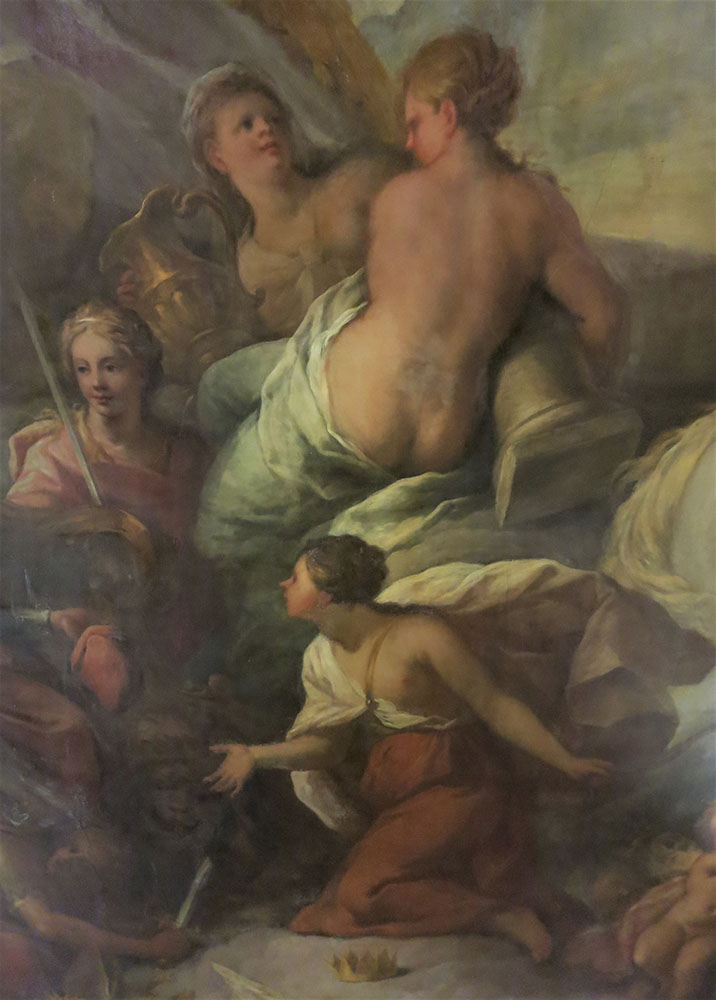
The Painted Hall is a very welcome addition to the literature of British art. It fills a gap. Ann Robey has done a splendid job in bringing together the individual elements by the four authors to make a coherent, attractively presented and well written book. We may cavil at the treatment of the illustrations: not all are numbered and those which are numbered are in three separate groups according to author, as if these were journal essays (1-50, 1-35, 1-37), making referencing cumbersome; the locations of associated paintings and drawings are not given, but they could easily have been included in the captions – page number references in the picture credits tells us who owns the copyright in the image, not the location of the original. A chronology of the building and its painting and of Thornhill’s life and work would also have been useful in aiding our understanding of the period and the work. But notwithstanding these difficulties and the known unknowns discussed above (which future scholarship will surely address), this book deserves a wide audience. It will provide a lasting record of the original painting and the recent restoration of an often overlooked masterpiece.
Note: all photographs are by the author.
please let us know details about paint in Queen Ann 2 STUART CATHEDRAL